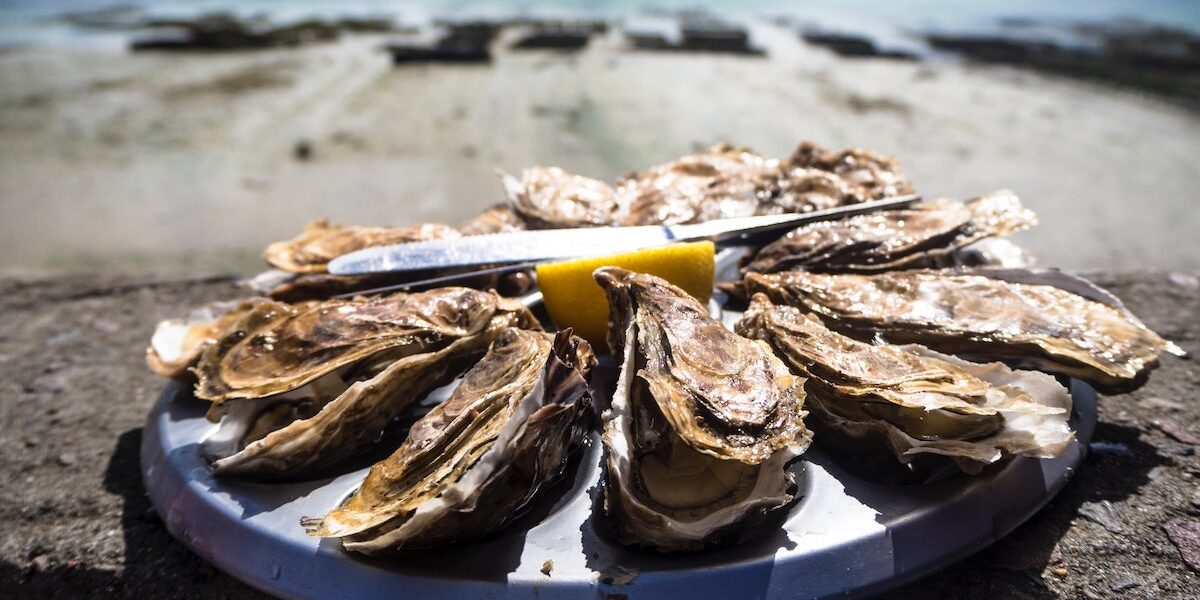by Alexis Valauri-Orton, Program Associate
In the streets of Lau Fau Shan, a small community in the Northwest tip of Hong Kong’s New Territories, the air smells sweet and salty. On a sunny day, hundreds of oysters lie atop drying racks – the town squares transformed into factories for Lau Fau Shan’s famous delicacy, the sundried “golden” oyster. At the small harbor, banks and jetties are built from stacks of oyster shells.
Just three years ago I walked these streets, and it seemed as though this centuries-old oyster farming industry was on the verge of collapse. I was there as part of my year-long Thomas J. Watson Fellowship, studying how ocean acidification might affect marine-dependent communities.
Mr. Chan, the youngest of the oyster farmers when I visited Lau Fau Shan in 2012, stands on the edge of the bamboo floats and lifts one of the many oyster lines that hang below.
I met with the oyster farmers of the Deep Bay Oyster Association. Each man I shook hands with shared the same surname: Chan. They told me how 800 years ago, their ancestor was walking in the muck of Shenzen Bay and tripped on something hard. He reached down to find an oyster, and when he cracked it open and found something sweet and savory, he decided he would find a way to make more of them. And since then, the Chans have been farming oysters in this bay.
But one of the younger members of the family told me with concern, “I am the youngest, and I don’t think there will be any more after me.” He told me how over the years their oysters had been slammed with environmental harm – dyes from garment factories upstream the Pearl River in the 80’s, the constant threat of untreated water. When I explained how ocean acidification, the rapid decline in oceanic pH due to carbon dioxide pollution, was ravaging shellfish farms in the Unites States, his eyes grew wide with concern. How will we cope with this, he asked?
When I visited Lau Fau Shan, the oyster farmers felt abandoned – they did not know how to cope with a changing environment, they didn’t have the equipment or technology to adapt, and they didn’t feel they had support from the government to recover.
But in three years, everything has changed. Dr. Vengatesen Thiyagarajan of Hong Kong University has been studying the effects of ocean acidification on oysters for years. In 2013, his PhD student, Ginger Ko, helped to organize an oyster symposium to advertise local Hong Kong oysters to students and faculty, and they invited the farmers of Lau Fau Shan to come and present on their products.
Catalyzed by this workshop, a partnership blossomed. Since this workshop, Dr. Thiyagarajn, Ms. Ko and others from Hong Kong University have teamed up with the oyster farmers and the Hong Kong government to build a plan to revive the industry.
Their first step is to understand the environmental threats the oysters of Lau Fau Shan endure, and to develop strategies for addressing them. With the support of a grant from the local government’s Sustainable Fisheries Development Fund, the researchers from Hong Kong University are installing an ultraviolet sterilization system. Once the oysters are removed from Deep Bay, they will sit in this system for up to four days, where any bacteria they may have absorbed will be removed.
The second phase of the project is even more exciting: the researchers plan to open a hatchery in Lau Fau Shan that will allow the oyster larvae to flourish in a controlled environment, free from the threat of ocean acidification.
Employees of the Deep Bay Oyster Cultivation Association stand outside of their office in Lau Fau Shan.
I think back to three years ago. After I told Mr. Chan about ocean acidification, and showed him pictures from the failed spawning at Taylor Shellfish’ hatcheries, I provided a message of hope. I told him how in Washington State, oyster farmers, tribal leaders, government officials and scientists had come together to address ocean acidification – and they had succeeded. I showed him the Blue Ribbon Panel report, and talked about how hatchery managers had developed strategies for rearing larvae safely.
Mr. Chan had looked at me and asked, “Can you send me these things? Could somewhere come here and teach us how to do this? We just don’t have the knowledge or the equipment. We don’t know what to do.”
Now, Mr. Chan has what he needs. Thanks to the inspiring partnership between Hong Kong University, the local government and the oyster farmers of Lau Fau Shan, a treasured industry and source of immense pride and history will persevere.
This story demonstrates the critical value of collaboration. If Hong Kong University had not held that symposium, what would have happened to Lau Fau Shan? Would we have lost another industry, another source of food and income, and another cultural treasure?
There are communities like Lau Fau Shan around the world. At The Ocean Foundation, we are working to replicate what Washington State was able to accomplish with its Blue Ribbon Panel around the United States. But this movement needs to grow – to every State and around the world. With your help, we can achieve this.







